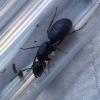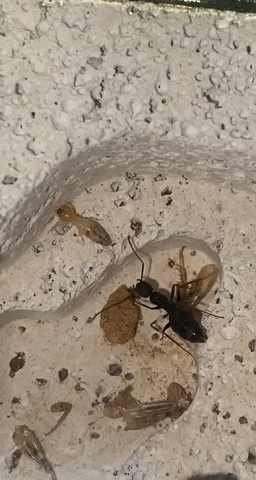
(day i caught her)

(1 week ago)
It has been a little bit over a month since i caught this queen and she has her first pupae and 2 more larvae that will be spinning soon, i will update with pictures in the morning

Sent from my iPhone using Tapatalk






Edited by ElisAnts, January 25 2022 - 3:19 PM.
My smaller colony also lost a worker after diapause. I assume this is just nanitics dying off. I'll be pulling my larger colony out on the 2nd next week. Hopefully I won't have too many die off.
Currently kept species
L. neoniger, P. occidentalis, C. modoc, C. novaeboracensis, C. vicinus, T. immigrans, A. occidentalis, S. molesta, P. imparis, M. kennedyi, M semirufus, F. pacifica, P. californica, M. ergatogyna.
Previously kept species
T. rugatulus, B. depilis.
Looking for
Myrmecocystus pyramicus, Myrmecocystus testaceus
Pheidole creightoni, Pheidole inquilina, Crematogaster coarctata, Crematogaster mutans
That is a little worrisome, however how many of those 9 were from the first generation of workers?
Currently kept species
L. neoniger, P. occidentalis, C. modoc, C. novaeboracensis, C. vicinus, T. immigrans, A. occidentalis, S. molesta, P. imparis, M. kennedyi, M semirufus, F. pacifica, P. californica, M. ergatogyna.
Previously kept species
T. rugatulus, B. depilis.
Looking for
Myrmecocystus pyramicus, Myrmecocystus testaceus
Pheidole creightoni, Pheidole inquilina, Crematogaster coarctata, Crematogaster mutans
That is a little worrisome, however how many of those 9 were from the first generation of workers?
When they are dying, what's their behavior like? Are they spinning in circles? Just dead suddenly?
Edited by TacticalHandleGaming, January 26 2022 - 5:02 PM.
Currently kept species
L. neoniger, P. occidentalis, C. modoc, C. novaeboracensis, C. vicinus, T. immigrans, A. occidentalis, S. molesta, P. imparis, M. kennedyi, M semirufus, F. pacifica, P. californica, M. ergatogyna.
Previously kept species
T. rugatulus, B. depilis.
Looking for
Myrmecocystus pyramicus, Myrmecocystus testaceus
Pheidole creightoni, Pheidole inquilina, Crematogaster coarctata, Crematogaster mutans
When they are dying, what's their behavior like? Are they spinning in circles? Just dead suddenly?
When they are dying, what's their behavior like? Are they spinning in circles? Just dead suddenly?
I have 2 videos that i could show you, its super weird…
Sent from my iPhone using Tapatalk
What are you feeding them? My C. Modoc love fruit flies. I pulled my bigger colony out early and they haven't had any die offs, just eating like crazy!
If you want to DM me some videos, I want to help.
Currently kept species
L. neoniger, P. occidentalis, C. modoc, C. novaeboracensis, C. vicinus, T. immigrans, A. occidentalis, S. molesta, P. imparis, M. kennedyi, M semirufus, F. pacifica, P. californica, M. ergatogyna.
Previously kept species
T. rugatulus, B. depilis.
Looking for
Myrmecocystus pyramicus, Myrmecocystus testaceus
Pheidole creightoni, Pheidole inquilina, Crematogaster coarctata, Crematogaster mutans
When they are dying, what's their behavior like? Are they spinning in circles? Just dead suddenly?
I have 2 videos that i could show you, its super weird…
Sent from my iPhone using Tapatalk
What are you feeding them? My C. Modoc love fruit flies. I pulled my bigger colony out early and they haven't had any die offs, just eating like crazy!
If you want to DM me some videos, I want to help.
yeah, mine have had zero die offs since I pulled them out
I seriously think fruit flies are the trick for keeping colonies going/successful colonies. Not sure if it's just because their easier for colonies to process, or if there's some special nutrients or something.
Currently kept species
L. neoniger, P. occidentalis, C. modoc, C. novaeboracensis, C. vicinus, T. immigrans, A. occidentalis, S. molesta, P. imparis, M. kennedyi, M semirufus, F. pacifica, P. californica, M. ergatogyna.
Previously kept species
T. rugatulus, B. depilis.
Looking for
Myrmecocystus pyramicus, Myrmecocystus testaceus
Pheidole creightoni, Pheidole inquilina, Crematogaster coarctata, Crematogaster mutans
I seriously think fruit flies are the trick for keeping colonies going/successful colonies. Not sure if it's just because their easier for colonies to process, or if there's some special nutrients or something.
I have to disagree. Crickets work very well. Just to have a good reaction from the ants make sure to cut the cricket in half. I've also seen that termites are also amazing for ants.
I seriously think fruit flies are the trick for keeping colonies going/successful colonies. Not sure if it's just because their easier for colonies to process, or if there's some special nutrients or something.
I have to disagree. Crickets work very well. Just to have a good reaction from the ants make sure to cut the cricket in half. I've also seen that termites are also amazing for ants.
I agree with both of you
I seriously think fruit flies are the trick for keeping colonies going/successful colonies. Not sure if it's just because their easier for colonies to process, or if there's some special nutrients or something.
I have to disagree. Crickets work very well. Just to have a good reaction from the ants make sure to cut the cricket in half. I've also seen that termites are also amazing for ants.
I've had okay luck with crickets. They just die off very quickly. I have had good luck with termites as well, but they are not my main feeder insect.
Currently kept species
L. neoniger, P. occidentalis, C. modoc, C. novaeboracensis, C. vicinus, T. immigrans, A. occidentalis, S. molesta, P. imparis, M. kennedyi, M semirufus, F. pacifica, P. californica, M. ergatogyna.
Previously kept species
T. rugatulus, B. depilis.
Looking for
Myrmecocystus pyramicus, Myrmecocystus testaceus
Pheidole creightoni, Pheidole inquilina, Crematogaster coarctata, Crematogaster mutans

Fresh eggs is a good sign. I hope the colony recovers quickly from whatever their issue was.
Currently kept species
L. neoniger, P. occidentalis, C. modoc, C. novaeboracensis, C. vicinus, T. immigrans, A. occidentalis, S. molesta, P. imparis, M. kennedyi, M semirufus, F. pacifica, P. californica, M. ergatogyna.
Previously kept species
T. rugatulus, B. depilis.
Looking for
Myrmecocystus pyramicus, Myrmecocystus testaceus
Pheidole creightoni, Pheidole inquilina, Crematogaster coarctata, Crematogaster mutans


Edited by ElisAnts, February 19 2022 - 11:51 AM.
Glad to hear they are bouncing back. I look forward to seeing their growth this year.
Currently kept species
L. neoniger, P. occidentalis, C. modoc, C. novaeboracensis, C. vicinus, T. immigrans, A. occidentalis, S. molesta, P. imparis, M. kennedyi, M semirufus, F. pacifica, P. californica, M. ergatogyna.
Previously kept species
T. rugatulus, B. depilis.
Looking for
Myrmecocystus pyramicus, Myrmecocystus testaceus
Pheidole creightoni, Pheidole inquilina, Crematogaster coarctata, Crematogaster mutans
0 members, 1 guests, 0 anonymous users